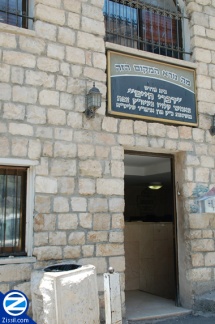Sanz Synagogue Safed
The Sanz synagogue, the “Divrei Chaim” is one of Safed’s oldest Ashkanazi synagogues. Members of the local Sanz Chassidic community use the synagogue for prayer and study together with other Tzfat residents and visitors. The Sanz shtiebel is known for its “minyan-mill” which offers numerous prayer quorums throughout the day.
Contents |
[edit] Sanz Hassidim in Tzfat
The Sanz Hassidic dynasty was founded in the Polish city of Nowy Sacz by Rabbi Chaim Halberstam, known as the “Divrei Chaim” who died in 1876. A group of Sanz Hassidim immigrated to Tzfat during the middle of the 19th century and established the Sanz synagogue in 1870 under the direction of Rabbi Chaim Halberstam’s oldest son, Rabbi Yechezkel Shraga Halberstam, Shinever Rov. The synagogue was named the “Divrei Chaim” in honor of Rabbi Chaim Halberstam.
[edit] Gate of Heaven
Rabbi Chaim taught that all prayers must travel through the Land of Israel, specifically Tzfat on their way to heaven and this was the 'Gate to Heaven'. He felt that his own meditations would benefit if his community supported a synagogue in Israel. Rabbi Chaim wanted to travel to the Land of Israel but was not able to undertake the journey. He asked his eldest son, Rabbi Yechezkel Shraga, to undertake the establishment of a synagogue in Tzfat for the Sanz Chassidim who had moved to the city.
[edit] Early Sanz Community
The original Sanz community was comprised of approximately 100 Sanz Hassidim. Their numbers fluctuated widely during the course of historical events in the city, but by the 1970's the community began to enjoy a resurgence, encouraged by the Sanz-Klausenberger Rebbe, Rabbi Yekusiel Yehuda Halberstam, the 'Shefa Chaim' of Netanya Israel. At this time the Sanz Shul underwent a renovation and a Mikva was created.
[edit] Present-Day Sanz Synagogue
The Sanz community in Safed is centered around the synagogue on Rehov Tarpa. The location of the Sanz synaogogue is close to the central square of the Old Jewish Quarter, Kikar HaMeginim. The synagogue was renovated in 2001 and the Beis Medrash and Ezras Nashim were expanded. In 2004 a new Beit Midrash -- study hall, called “Heichal Zichron Yitzhak” was created. The southern wall of the synagogue, where the “Aron Kodesh” -- Ark of the Torah Scroll -- is located, is the original wall of the first Sanz synagogue.
![]() Read full Zissil article on the Sanz community in Tzfas
Read full Zissil article on the Sanz community in Tzfas
[edit] Sanzers
The Sanz Hassidim in Tzfat maintain close ties with the various Sanz communities in Bnai Brak, Jerusalem, Netanya and Boro Park in Brooklyn. In addition to the Sanz congregants, many other men pray at the Sanz synagogue, including Sepharadi, Ashkanazi, Hassidic and non-Hassidic.
[edit] Minyan Mill
The Sanz Shtiebel is one of the few places in Tzfat where men can find a “minyan” -- prayer quorum -- at almost any time of the morning. Morning minyanim begin every half hour, starting at approximately 7:00a.m. and ending between 9:00a.m. - 10:30a.m., depending on the time of year. There are also at least two minyanim for Mincha and Mariv. During peak tourist seasons such as Bin Hazmanim more minyanim are added, making the Sanz Shul very popular for Tzfat vacationers. On Shabbos there is only one Minyan for Kabbalat Shabbos and Shachris.
[edit] Rules
In line with the chassidic opinion, the Sanz Shul does not allow any minyanim for Mariv to take place before Tzes HaKochavim of Rabbanue Tam. They also will not allow any person to serve as Shliach Tzibur if he is not wearing long hasdic garb or a coat. During Mincha / Mariv the Shliach Tzibur must wear a hat.
[edit] Managment
The Sanz Shul is managed by the gabbi, Baruch Klien who is also known as a money changer. Rabbi Zev Riche serves as the head Rabbi. Rabbi Horowitz leads the Kollel and along with Rabbi Riche and Rabbi Yichezkel Shimon answer Halachic questions for residents of Tzfat.
[edit] Women’s Galley
As an Orthodox synagogue the Sanz synagogue follows the Orthodox requirements that men and women pray separately. The women’s galley is on the second floor of the synagogue and offers easy viewing of the men’s section below. Women use the area during the Sabbath and holiday services and the men use it to start new minyans during the weekday services when the downstairs sanctuary is already in use.
[edit] Mikvah
The Sanz “mikva” -- ritual bath -- is one of the largest in the Old Jewish Quarter of Safed (the Breslev mikva is the largest). The men’s mikve is open to men during the daytime while a second mikve for women is available to women in the evenings. All mikvas are clean and well-attended.
In the mens mikva there are two mikvas, one is well-heated and the other is kept at room-temperature for men who prefer the colder water. There are showers in the Mens mikva and a fee is collected for the mikve’s use.
[edit] Kitchen Utensils
A small mikvah for utensils sits outside the Sanz synagogue. Both men and women can access the mikve for dishes and other culinary items.
Several days before the Passover holiday a staff of men maintain a huge boiling pot of water for 'Haggala' where people can immerse suitable utensils that they plan to use for Passover.
| |||||||||||


